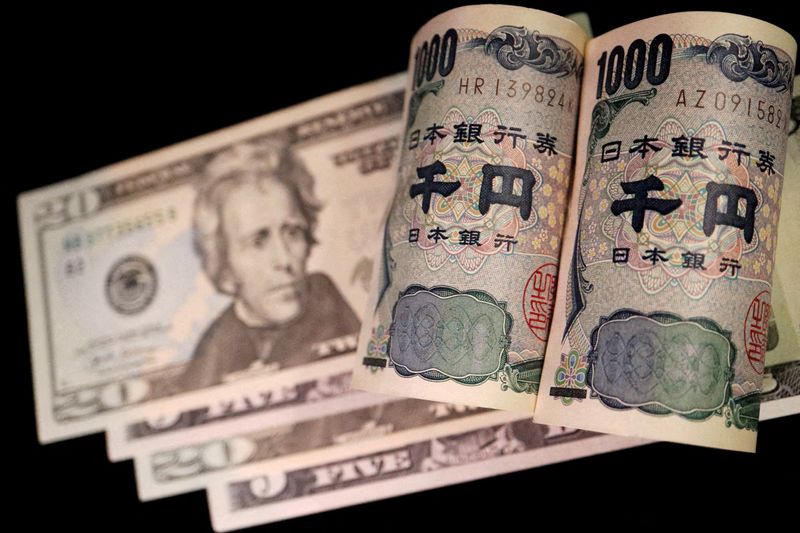By Brigid Riley
TOKYO (Reuters) - As the yen plumbs three-decade lows and pressure grows on Japan to intervene or make monetary policy changes, traders figure there is not much Tokyo can do to reverse the currency's slide while interest rates and momentum are heavily skewed against it.
The Bank of Japan (BOJ) sets policy on Friday with almost no expectation of a rate rise.
It has no currency mandate but a weakened yen, which is at a 34-year trough on the dollar and record low levels in real terms, affects inflation because it raises import prices.
Politicians have been describing its slide as excessive and BOJ Governor Kazuo Ueda has hinted at future rate hikes.
Yet traders in foreign exchange markets, in thrall to a rising dollar, have barely stopped selling the yen through some 16 months of important and theoretically yen-positive shifts culminating in the BOJ’s first rate hike in 17 years in March.
Japan has sloughed off yield caps and negative interest rates. The central bank has flagged a retreat from the bond market. And still the yen has remained the cheapest major currency to borrow and short-sell - all but sealing its fate.
"In the short-term, BOJ hiking policy rates might not make material difference to the yen. The yen is currently driven more by U.S rates and the yield differential which is significant," said Nathan Swami, Asia-Pacific head of foreign exchange trading at Citi in Singapore.
"It might take a while for the BOJ to normalise policy fully and that should start to help strengthen the yen but the key question is what the Fed does in the meantime."
Increasingly, and to the delight of yen bears, markets expect the Fed will not do much. Pricing for as many as six Federal Reserve interest rate cuts this year has unwound on signs of sticky U.S. inflation and economic strength. Barely two are now anticipated.
That leaves short-term U.S. rates above 5.25% for longer, while short-term Japanese rates sit at 0.1%, meaning the 22 bp increase priced in for Japan this year hardly moves the dial.
At the ten-year tenor, U.S. yields are 375 basis points higher than Japanese yields, with the gap not far from over 400 bps touched last year - the widest in two decades.
The yen traded as low as 155.74 this week. It is down 9.4% on the dollar this year and has lost more than 33% of its value in three years. This year the U.S. dollar index is up 4.3%.
"When the dust settles, you're still looking at a significant interest-rate differential," said Bart Wakabayashi, branch manager at State Street (NYSE:STT) in Tokyo.
JOB DONE
Market focus at the BOJ meeting falls mostly on three elements: policymakers' inflation forecasts - where a rise would imply higher rates - governor Ueda's tone at his news conference, and the central bank's plans for bond buying.
On all fronts investors see the central bank's ability to move or surprise markets as limited, particularly as it already made a landmark exit from negative rates at its meeting in March.
Inflation is nascent and, at 2.7%, is far lower than in the West. Sharp (OTC:SHCAY) rises in borrowing rates would be disruptive for Japan's heavily indebted government and economy and so are likely to be avoided.
Government bonds offer yields far below foreign sovereigns, which draw a constant flow of Japanese money abroad, weighing on the yen. The market is also so dominated by the BOJ, which owns more than half Japan's quadrillion or so yen of debt on issue, that an unwinding is expected to take years, at least.
Even if the BOJ were to cut its 6 trillion yen a month purchases by around one trillion yen, it would only lift the 10-year yield about two basis points, said Nomura strategist Naka Matsuzawa - hardly enough to shift investment flows.
"Basically, I think the BOJ has done its job in (the) March meeting, including supporting the yen," he said.
To be sure, the speculators in the currency market hold their largest short yen position for 17 years, meaning a policy surprise would likely spook them and drive the yen up sharply.
Intervention would also clear out shorts, but on its own is seen as unlikely to be able to reverse the yen's course. Even large bursts of yen buying is just a drop in the bucket compared to the $7.5 trillion that change hands daily in the foreign exchange market.
Japan is estimated to have spent as much as $60 billion defending the currency in 2022.
"Intervention would definitely help dislodge speculative positioning in the short term," said Citi's Nathan Swami.

"However, it might not fundamentally change the path of the currency…as we saw in the last rounds of interventions in September and October 2022, the yen did strengthen significantly initially post-intervention but might have provided longer term yen bears better entry levels to re-enter."
($1 = 155.4600 yen)